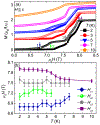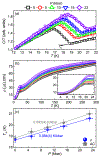Electronic and magnetic properties of stoichiometric CeAuBi2
- PMID: 34141976
- PMCID: PMC8207490
- DOI: 10.1103/PhysRevB.101.214431
Electronic and magnetic properties of stoichiometric CeAuBi2
Abstract
We report the electronic and magnetic properties of stoichiometric CeAuBi2 single crystals. At ambient pressure, CeAuBi2 orders antiferromagnetically below a Néel temperature (TN ) of 19 K. Neutron diffraction experiments revealed an antiferromagnetic propagation vector , which doubles the paramagnetic unit cell along the c axis. At low temperatures several metamagnetic transitions are induced by the application of fields parallel to the c axis, suggesting that the magnetic structure of CeAuBi2 changes as a function of field. At low temperatures, a linear positive magnetoresistance may indicate the presence of band crossings near the Fermi level. Finally, the application of external pressure favors the antiferromagnetic state, indicating that the 4f electrons become more localized.
Figures






References
-
- Tokura Y, Kawasaki M, and Nagaosa N, Nat. Phys 13, 1056 (2017).
-
- Hochberg Y, Kahn Y, Lisanti M, Zurek KM, Grushin AG, Ilan R, Griffin SM, Liu Z-F, Weber SF, and Neaton JB, Phys. Rev. D 97, 015004 (2018).
-
- Smejkal L, Zelezny J, Sinova J, and Jungwirth T, Phys. Rev. Lett 118, 106402 (2017). - PubMed
-
- Schoop LM, Pielnhofer F, and Lotsch BV, Chem. Mater 30, 3155 (2018).
-
- Nagaosa N, Sinova J, Onoda S, MacDonald AH, and Ong NP, Rev. Mod. Phys 82, 1539 (2010).
Grants and funding
LinkOut - more resources
Full Text Sources
